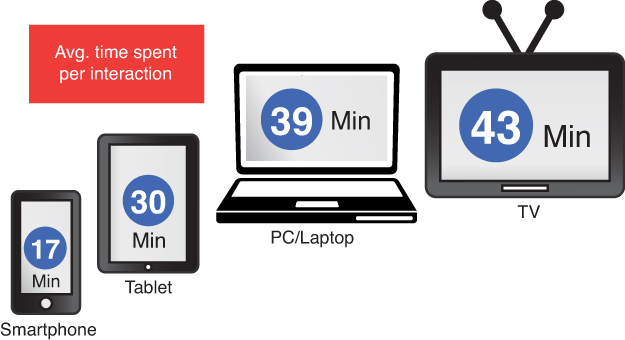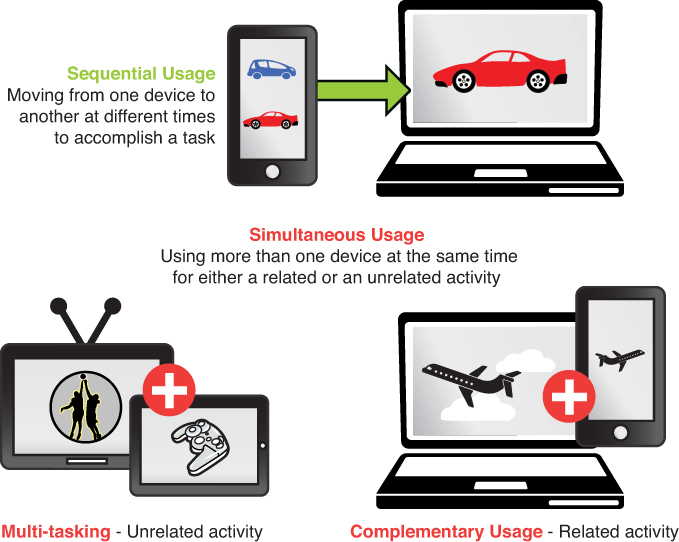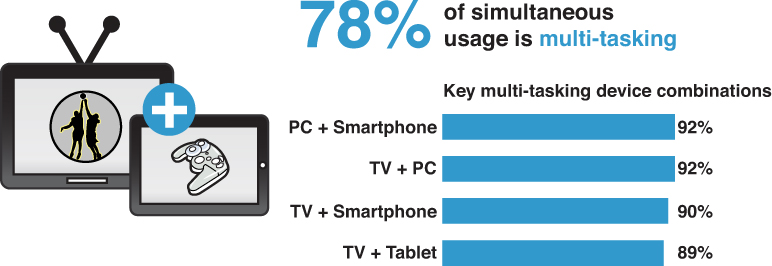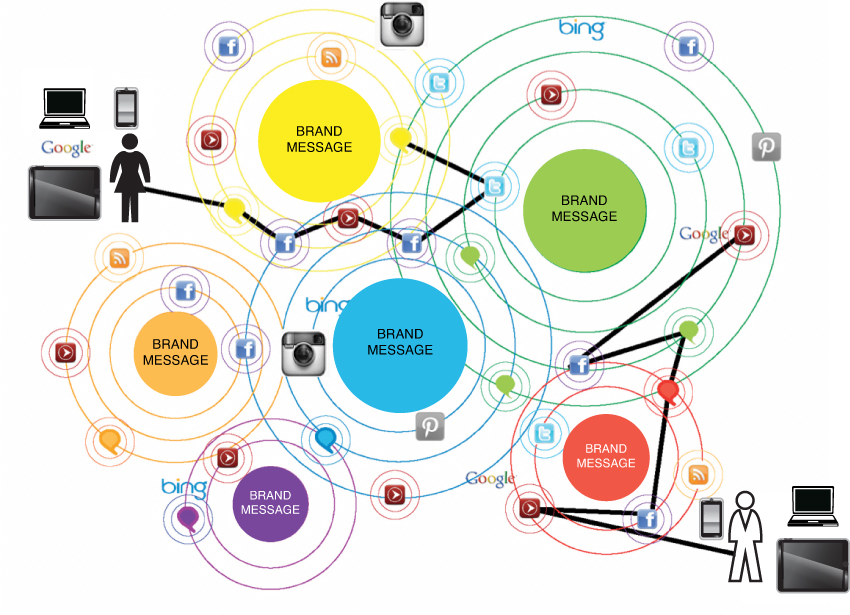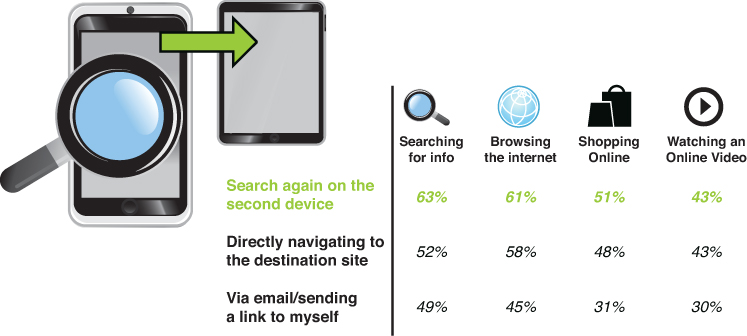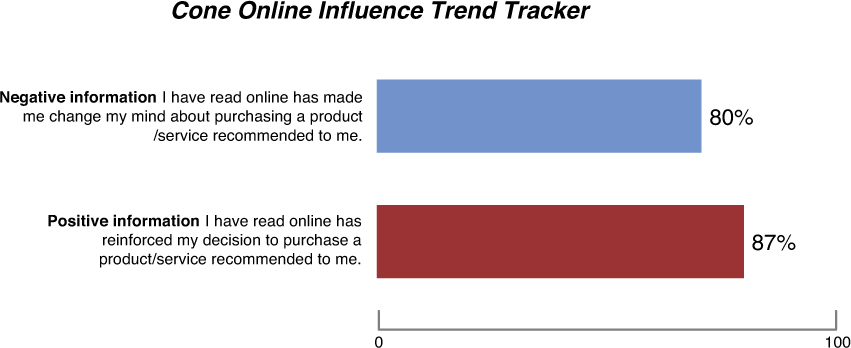1. Understanding the Social Customer and the Chaotic World We Live In
“Tweetable Moment: Ninety percent of all media consumption, or 4.4 hours a day, happens across phones, tablets, computers, and TVs.”
—#nextmediaco
I wake up every day about 6:00 a.m. The first thing I do to start my day is check all the notifications on my phone. I open up the Hootsuite app, refresh it, and check my @mentions, retweets, and direct messages. I also check for any new followers. I then go to Facebook and check if anyone commented on, liked, or shared any of my content. I check my feed, and at times I go on a liking frenzy of my own. Instagram is next, and I normally check to see who friended me and liked and/or commented on any photos in my stream. Sometimes I spend a few minutes liking and commenting on others’ photos as well. LinkedIn is usually the last social network I check, specifically to see who has been stalking my profile followed by LinkedIn Today. Texts, emails, and phone messages are usually done later in the morning.
I then head downstairs, turn on the TV, make my breakfast, and read the latest news on Pulse from my iPad Mini while eating oatmeal and glancing up at the morning news on television. I usually share interesting news on Facebook, Twitter, or both if I have time. After breakfast, life is a little more routine—wake up the kids, make them breakfast and lunch, and then get them out the door and off to school.
When I get to work, my online behavior is rarely ever routine. Between meetings and sometimes during, I randomly check my networks or Google things I need to know and tweet along the way. Each day is different, dynamic, and very unpredictable. It’s very difficult, even for me, to determine my next move or what content I will consume next.
Sound familiar?
It should because many consumers (of which you’re one too) behave in a very similar fashion and it’s only going to get worse. The amount of content, media, and overall marketing messages will only grow. It’s inevitable and we can thank technology innovation, the multitude of devices, and a healthy economy for that. And our attention spans will always remain constant, which is why we filter out noise and only consume content and media that are important to us at a very specific moment in time. I won’t spend more than a chapter trying to convince you that the world we live in today is like no other and that reaching consumers is difficult to do. I think you already know that. It’s probably one reason you bought this book.
But as you read on and prepare to transform your brand into a media company, there are several factors you should consider as it relates to today’s fast-paced, dynamic, and unpredictable marketplace:
• We live in a multi-screen economy.
• CADD (Customer Attention Deficit Disorder) is among us.
• Relevance is key to content consumption.
• The customer journey is dynamic.
• Customers are influential.
This chapter takes a closer look at these factors.
We Live in a Multi-Screen Economy
In 2012, Google, in partnership with market analysts Ipsos and Sterling Brands, released a study titled, “The New Multi-screen World: Understanding Cross-Platform Consumer Behavior.” The report stated that 90% of consumers move between multiple devices to accomplish a specific task, whether it’s on smartphones, PCs, tablets, or the television. That means 9 out of 10 people have more than one device for consuming content and even more media. In its most simplest terms to convey the difference between content and media is that content is information (that is, tweets, status updates, and so on) carried by or transmitted by a specific media (device, social network, or application.)
The study revealed that although a lot of market attention is being focused on smartphone usage, this device isn’t used for media consumption as much as the others: 17 minutes per interaction, compared to 30 minutes on tablets, 39 minutes on PCs, and 43 minutes watching television. Figure 1.1 shows a breakdown of usage across each device.
However, though smartphones have the shortest usage times, they are often used as a starting point for consumers when they begin specific tasks. Google calls it sequential screening or device usage. Simultaneous screening is multiple device usage at the same time either for a related or unrelated activity.
More specifically, the study found that 9 out of 10 consumers use multiple screens sequentially, so starting a specific task such as searching for a product or service, booking a flight online, or managing personal finances doesn’t just happen on one device. In fact, 98% of the consumers surveyed move between multiple devices to finish the tasks they started earlier in the day.
In the world of simultaneous device usage, the study found that television is no longer front and center commanding our undivided attention, with 77% watching the tube while using other devices to perform random tasks. In many cases consumers use their smartphones or tablets to search for something they just watched during a television show or check emails during the commercial. Sounds a lot like my behavior if you ask me. Figure 1.2 illustrates the differences between sequential and simultaneous device usage models.
So what does this study mean for you and your brand? As you create content, whether it be videos, photography, infographics, or simply the development of a website’s user interface, you must take into consideration the number of devices, screens, and operating systems in the marketplace and optimize for each one. This is a huge shift even from just a few years ago when you only had to worry about different screen resolutions on computer displays.
All successful brands have an amazing story to tell.
Additionally, given the dynamic nature of consumers’ device usage, you must also ensure that there is a level of consistency in the way you tell your brand story. All successful brands have an amazing story to tell. From the brand identity, to the website and blog, to the Facebook page and the content you share on it, each piece of content needs to contribute a chapter to that story. Successful stories allow customers to connect with you emotionally. When that connection is made, those customers are more likely to choose your brand over the one that doesn’t have a story to tell or has one that’s disjointed, boring, or doesn’t align to their interests. It’s much like dating. Wouldn’t you would rather go out on a date with someone who is amazing, inspiring, and tells good stories rather than someone with no personality or interesting story?
TOMS and Zappos are two brands that have amazing stories. In TOMS’ case, most consumers know that for every pair of shoes purchased, a pair is donated to a child in need. When they sell a pair of eyewear, part of the profit is used to save or restore the eyesight for people in third-world countries. That’s their story, and they stick to it everywhere they have presence online. Customers feel good when they purchase a pair of TOMS shoes and they tell others about it too.
The Zappos story is all about the culture of customer service and delivering happiness to each of their 24+ million customers. It’s not only a great story, but it’s simple to communicate to others, which Zappos does extremely well. It’s also true. If you ever have an issue with a Zappos product and tweet about it, an army of Zappos employees will respond to you and ask how they can help.
Finally, you must also ensure that search engine visibility is a focal point of your mobile content strategy. What’s the point of optimizing content for various screens and devices if it’s not even discoverable in search? Lee Odden, author of Optimize: How to Attract and Engage More Customers by Integrating SEO, Social Media, and Content Marketing, states in his book that any and all content on the Internet can be searched, so any and all content that brands create can be optimized. Lee makes an excellent point here if you think about push versus pull marketing. When someone goes to Google, they are usually on a mission to find information. And you are doing yourself a disservice if your content is absent from the search results.
Because mobile content consumption is the gateway into search, social media, and all other forms of media, it must be central to your content strategy.
CADD (Customer Attention Deficit Disorder) Is Among Us
My daughter Milan turned 11 in September 2012. She decided to have a sleepover at our house with 10 of her girlfriends from school to celebrate. Halfway through the night, I noticed that it was awfully quiet downstairs in the living room—no talking, no laughing, no giggling—behavior that was common during sleepovers when I was a kid. I figured they were watching a movie because the volume on the television was unbearably loud. When I went to downstairs to see why they were so quiet, I noticed something interesting. With the TV flicking in the foreground, each of the 10 girls was looking down at her iPod Touch, playing games and texting at the same time. It’s the world we live in. It’s CADD.
The “New Multi-Screen World” Google study clearly illustrates that CADD is among us. The mere fact that consumers have more than one device paints a solid picture of this scenario. Figure 1.3 gives a clear illustration of how consumers are multitasking on each of those devices.
I have five devices myself, so I am certainly talking about yours truly here. We can blame the multitude of devices, all the marketing messages, coffee, or a combination of all three for our collective attention deficit, but the key takeaway here is that you are competing with more than just clutter and noise. For example, if you are a brand manager for Ford, you should be more concerned with the billions and billions of status updates, tweets, likes, and shares than what GM is doing in the social media space.
The content and media surplus and an attention deficit in the world today means that the content you create must be relevant.
Relevance Is the Key to Content Consumption
Consumers want relevance. I want relevance. We all want relevance. We are inundated daily with content and media that we just don’t care about, and it’s the sole reason why we create relevance filters.
Several years ago when I was planning to refinance my home, I remember driving down Highway 101 and seeing billboard after billboard after billboard of financial companies advertising their interest rates. I heard radio advertisements, read status updates, overheard conversations in the office, and even noticed display ads from Quicken Loans all over the Web. You might have experienced something similar when you were in the market to buy a new car or camera and noticed all the relevant advertisements that commanded your attention. The funny thing is that the very minute after I refinanced my home, each and every one of those brand messages went away. But they didn’t really go away. They just weren’t relevant to me anymore. My filters went back up, and I moved on.
Relevance is understanding what your customers are interested in and determining what you want to say that adds value to that interest and conversation. The difficulty is creating a content strategy that considers what’s important to your customers and at the same time is relevant to your brand message. For example, if you work for a jewelry manufacturing company, I don’t foresee cereal as being a part of your content strategy. It’s just not relevant to your brand or interesting to your customers. Fashion, on the other hand, could be more relevant since jewelry and fashion can be considered synonymous in some cases; and you may actually have license to talk about it. What you will have to do is create editorial principles that define how flexible you want to be with your content based on what your brand is comfortable talking about and what it’s not comfortable talking about. In Chapter 7, “Defining Your Brand Story and Content Narrative,” I will give you a step-by-step plan of action on how to create a game-changing content strategy—one that can truly change your customer’s behavior in a positive way.
The good news is that it’s not that difficult to identify what’s important to your fans within your communities. You probably already have a demographic profile that gives you the basics, so that’s a start. I am sure you have done some research using focus groups or surveys as well. And Facebook Insights does give additional information if you need it. But there are other things you can do to get more information about your customers’ interest graph. Many tools are available today in the marketplace such as Demographics Pro (http://www.demographicspro.com/), Simply Measured (http://simplymeasured.com), and Wisdom App (https://www.facebook.com/appcenter/wisdomapp) that can give you a complete breakdown of what other content, pages, and brands your fans also care about and use—basically a complete analysis of your customers’ interest graph.
One of my favorite tools in the market is Keyhole.co (formerly Visibli). Their claim is that over 90% of any brand’s audience doesn’t talk about the brand, so their focus is on what else a brand’s audience is talking about. Using their analytics toolset, you can get some serious intelligence about your audience on Twitter, specifically what types of content they share among themselves, which topics they care about most, which websites they share from, and other valuable insights. They provide three levels of intelligence:
• Follower Intelligence: This can give you detailed insights into your specific audience, including what your followers are interested in, which stories they are sharing and talking about most, which domains they share content from, who among them is the most influential or engaged, as well as who influences them.
• Competitor Intelligence: This is the same data as Follower Intelligence but gives insight into the followers of competitive brands, to help with competitor audience targeting.
• Influencer Intelligence: This provides insights into what industry influencers are talking about, including which stories from within an industry are influencers most interested in, and which websites most of these stories are sourced from.
Keyhole also shows you the percentage of followers who are interested in certain categories such as science, technology, health and beauty, news and politics, movies and TV, music, sports and recreation, entertainment, books, food and drink, and shopping. Most importantly, it identifies where your audience over-/under-indexes against the industry and competitor audiences, so you know where to focus most of your energy.
For content and social marketers, Keyhole also identifies the top stories and topics that your audience is talking about in real-time, so that brands can act as true media companies and participate in the conversations that matter to their followers right now. These insights are valuable and give you more of a complete analysis of who your customers are and what they care about most.
For example, doing a quick analysis of Nike’s Twitter account, the results show that 31% of their community is interested in Sports & Recreation (obviously), 19% is interested in Health, and 10% in Fashion & Style. However, when we compare Nike’s audience to Reebok’s audience, we learn that Nike’s audience over-indexes in Sports & Recreation, but under-indexes in Health and Fashion & Style. This implies that while Nike’s audience might be more active in traditional sports, Reebok’s audience is more interested in healthy living, as well as apparel—great information to know when deciding how to best engage this audience and building your content strategy.
Nike’s audience also has a tendency of sharing Fashion & Style (that is, apparel) content from many well-known websites, such as Complex.com and DimeMag.com. However, for highest efficiency, we may want to know where Nike’s audience over-indexes compared to the rest of the world. From that perspective, the best website to target this audience on is TheShoeGame.com. They’re also comparatively heavy users of ChallengeLoop.com.
Platforms like Keyhole.co give you the ability to tailor your content and make it more relevant to your followers’ interests. All your customers want from your brand is stellar products or services, value, and relevance—and if you can’t deliver that, your competition will.
The Customer Journey Is Dynamic
We have already looked at the challenges of living in a multi-screen economy. We have also determined that many of us suffer from CADD and that all we want is content relevance. Those two factors alone make it difficult to reach consumers. So here is another factor to consider: We live in a noisy and dynamic world filled with media and messages, and we are inundated with content. If you don’t believe me, here are a few 2012 Facebook stats for you to digest before you read on (source: AllFacebook.com):
• Monthly active users on Facebook total 850 million.
• There are 250 million photos uploaded every day.
• Twenty percent of all page views on the Web are on Facebook.
• There are 425 million mobile users.
Twitter is seeing exponential growth and usage as well (source: Lab42.com):
• There are over 465 million Twitter accounts.
• Seventy-five million tweets are sent out per day.
• One million accounts are added to Twitter every day.
• The top three countries on Twitter are the United States at 107 million, Brazil at 33 million, and Japan at nearly 30 million.
I won’t bore you with more data, but we can’t forget the growth of networks such as LinkedIn, Google+, Instagram, and Pinterest. It’s no wonder we filter out the noise and only consume the content that is relevant to us at a very specific moment in time. There is just way too much going on in the world—too much content, too much media, and too much of everything. Figure 1.4 illustrates a day in the life of one of your customers and the amount of noise that surrounds him or her.
In my last book, Smart Business, Social Business, I wrote at length about the Edelman Trust Barometer, which is the largest exploration of trust, to date, and the largest survey of its kind. For 2013, Edelman surveyed more than 31,000 respondents in 26 markets around the world and measured their trust in institutions, industries, and leaders. One finding in the survey is that individuals need to hear, read, and see things three to five times before they start to believe it, which has been a consistent data point every year. So if your company is launching a new product or service, your customers need to hear it or read about it at multiple touch points. The same is true if you are launching an awareness campaign that’s trying to reposition your brand in the marketplace. So as I mentioned earlier in this chapter, your story must be consistent and tell a very similar story in every tweet, news article, status update, promoted post, search, and so on.
In fact, what’s interesting about the Google study mentioned earlier in this chapter is that search behavior links both sequential and simultaneous usage across multiple devices. In other words, we tend to use search as our gateway into specific content that we are looking for and in some cases perform similar searches on a different device. This makes your paid search and search engine optimization (SEO) strategies even that more critical. For example, and as illustrated in Figure 1.5, a high percentage of respondents claimed to have used search after performing various online tasks—a prior search, browsing the Internet, shopping online, or watching a video. The question you have to ask yourself is whether or not consumers will find your content when performing their search activities.
• Paid media (display ads, search, promoted posts, and sponsored stories)
• Earned media (influencer and advocate outreach programs and events)
• Owned media (Twitter, Facebook, YouTube, and blogs)
Chapter 9, “The Role of Converged Media in Your Content Strategy,” covers the various forms of media in great detail.
Customers Are Influential
How many times have you posted a status update about a negative experience you had with a brand? Perhaps it was a situation with your cable company, a restaurant, or maybe an airline. On the other hand, how many times have you read a status update from one of your friends about their positive experience with a brand? It could have also been a Yelp Review or product review on Amazon. Did that influence your decision to buy, or do you just ignore it? I see this type of behavior every single day in the social networks that I spend time in. If someone isn’t ranting about a certain brand they hate, they are praising the brands they love. So in most cases, you are influencing others based on the experiences you share about brands. Or, you are being influenced by others based on the experiences they share with you directly or after reading an online review. I have been on both sides of the field and am glad to say that I trust the opinions of the people in my community and hope they trust me.
Influence is a hot topic these days especially with the emergence of influencer scoring systems such as Klout, Kred, Peer Index, and Tweetlevel (an Edelman product). Andrew Grill, CEO of Kred, told me in an interview for this book that influencers don’t have to be celebrities; they can be anyone who people look up to and trust who has a respected opinion about any topic in a community.
I agree with Andrew, and the reality is that all of your customers are influential regardless of how many friends, fans, or followers they have. No, they probably don’t obsess over their Klout scores or get mad when their scores go down, but they are definitely influencing others to buy your products and, in some cases, to not buy your products. And they are doing this through organic and everyday conversations they are having with their friends, both online and offline.
To highlight a study that proves this point, the Cone Online Influence Trend Tracker, released in 2011, is somewhat dated but shows some interesting trends in customer behavior as it relates to influence. Figure 1.6 shows that 85% of consumers go online to research products before deciding to make a purchase. What’s interesting is that they do this research after someone has given them a recommendation. They want additional validation before they make the purchase.
Figure 1.7 shows that four out of five consumers have changed their minds about purchasing a product based solely on negative information they found online from other customers. This is up from just 68% of consumers who said the same thing in 2010.
The good news is that positive information about products and services has a similar effect on consumer decision making, with 87% of consumers agreeing that a favorable review has confirmed their decision to purchase. However, the survey suggests that negative information is gaining traction and is now just as powerful in tipping the scales against a recommended purchase.
This happened to me in the summer of 2012, as you learned in the Introduction of the book. It’s a great example of what I’m talking about here. After I heard some negative information about a specific airline, I did some additional research and found the very telling report from the U.S. Department of Transportation about the large number of pet deaths and injuries on that airline. So do you think I booked travel with them? No.
The net-net of this is data is that customers’ opinions matter a great deal in the digital ecosystem. And whether they know it or not, they are aiding and influencing other customers in seeking out products and services as well as guiding them down the purchase funnel simply through organic conversations about their experiences.
Business Objectives Stay the Same Despite the Changes Externally
I have covered a lot of information in this chapter as it relates to the external marketplace—media, marketing, customers, and influence. And when you try to couple it together and make some sense of it all, it can certainly get discouraging. Unfortunately, the market doesn’t stop changing when we get discouraged. To steal a popular slogan from the U.S. Marines, you need to improvise, adapt, and overcome—and be prepared to pivot your business operations quickly. Otherwise you and your brand will quickly become irrelevant.
There is a content surplus in the marketplace today, and consumers suffer from attention deficit. What is your brand doing to stand out?
Despite the changes that you need to adapt to externally, your business objectives will always remain the same internally. Your revenue goals will never go away. You still have to sell products despite the market conditions or economic state. The pressure of cutting operational and marketing costs and increasing margins will continue to drive business decisions. And though you might not have direct control over stock price, market share, or mind share, you still could be held accountable. The good news is that this book provides you with a roadmap that will help you adapt your thinking while operationalizing your content marketing strategy.
There is a content surplus in the marketplace today, and consumers suffer from attention deficit. What is your brand doing to stand out?
Vendor Spotlight—Social Flow
Earlier in this chapter, I talked about the need for you to create relevant content to reach consumers with CADD. The challenge here is what might be relevant today might not be relevant tomorrow. And to complicate it a little further, what might be relevant an hour ago might not be relevant right now. Attention is finite, and you don’t have a lot of time to get your message in front of the masses. SocialFlow addresses this issue head on.
The best way to describe SocialFlow is that it’s a content publishing and ad platform that uses real-time analytics and a predictive algorithm to publish content at the time when customers are paying attention. They have two core products, Cadence and Crescendo.
As depicted in Figure 1.8, Cadence uses predictive analytics to determine the value of your content within the social graph. In real time, Cadence determines when a specific audience is available, paying attention and what relevant topics they are most likely to engage with based on what they are currently discussing. It then automatically publishes your content when the audience is paying attention. SocialFlow then ties these messages back into business goals by measuring the conversion rate of each message, such as clicks to a website as measured by a web analytics platform like Adobe SiteCatalyst or Google Analytics.
SocialFlow’s Crescendo product, also referred to as their Attention Buying Platform, uses proprietary technology to optimize “interest targeting” based on real-time conversations pulled in from the social graph, rather than using traditional demographic filters. As seen in Figure 1.9, the platform then optimizes the acquisition of custom audiences, sponsored actions, sponsored stories, promoted posts, and mobile app installs all while tracking very specific conversions. In a nutshell, the platform is smart enough to bid on the right keywords for Facebook ads that reflect what their most engaged fans are talking about and sharing at that precise moment. So instead of buying against larger buckets of expensive keywords, Crescendo can buy key terms that are being discussed in real time and for less money.

Figure 1.9 Crescendo informs ad-buying decisions and maximizes returns using real-time trending data.
Crescendo and Cadence naturally complement each other and highlight how paid and earned media can be integrated and can work together effectively. By building up a large community, you can tap into their conversations to learn how to target similar consumers outside of your own media. And ultimately, if the content is relevant and timely, it can turn a consumer into a fan and a fan into an advocate.
In addition to its core products, Cadence and Crescendo, SocialFlow also analyzes social signals and identifies when marketing dollars should be spent on Promoted Tweets, Promoted Posts, and Sponsored Stories, extending the reach of relevant content and coordinating marketing efforts on Twitter and Facebook.

